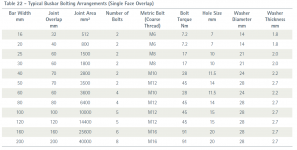kdlman
Member
- Location
- Ohio, United States
- Occupation
- Power Generator technician
I have a question on the bolting of bus bar together. I have 4" silver plated copper bus bar overlapping and need to know how many bolts are needed for proper compression and current flow. I have seen many installations that use 4- 1/2" bolts in this situation but need an engineering backup for my reasoning to go this way. Presently there are 2- 3/8" bolts holding these bus together that bolt into an insulator, the bolts for the insulator not the bus bar. 2,527 amps at 480 volts is the rated output of the generator, this not accounting for any surges or short circuit current. The bolts have been torqued and evidence of cold-copper flow is there with a 7/8" diameter ring under the bolt areas.
I'd like to get a written source to show those I'm trying to convince this needs to change.
I'd like to get a written source to show those I'm trying to convince this needs to change.

